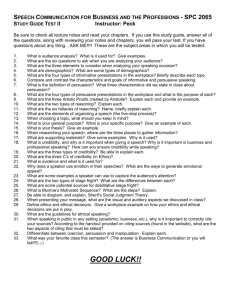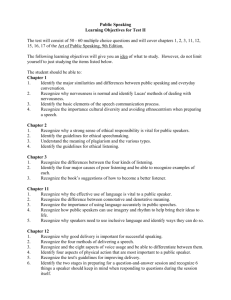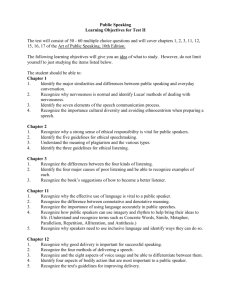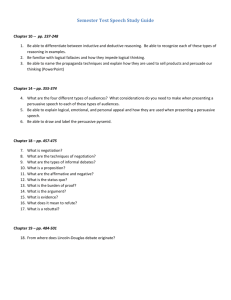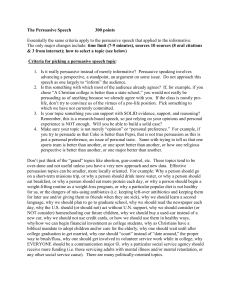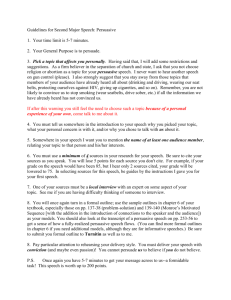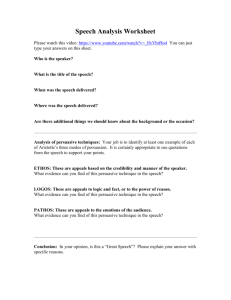Persuasive Speeches - Fountainhead Press
advertisement
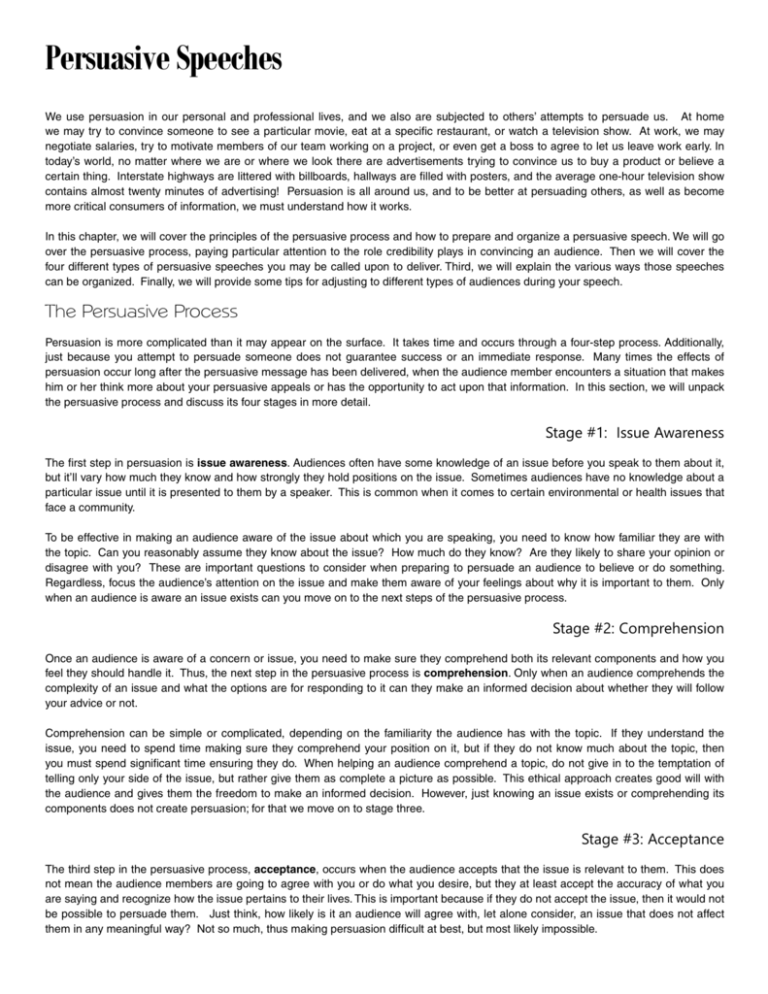
Persuasive Speeches We use persuasion in our personal and professional lives, and we also are subjected to others’ attempts to persuade us. At home we may try to convince someone to see a particular movie, eat at a specific restaurant, or watch a television show. At work, we may negotiate salaries, try to motivate members of our team working on a project, or even get a boss to agree to let us leave work early. In today’s world, no matter where we are or where we look there are advertisements trying to convince us to buy a product or believe a certain thing. Interstate highways are littered with billboards, hallways are filled with posters, and the average one-hour television show contains almost twenty minutes of advertising! Persuasion is all around us, and to be better at persuading others, as well as become more critical consumers of information, we must understand how it works. In this chapter, we will cover the principles of the persuasive process and how to prepare and organize a persuasive speech. We will go over the persuasive process, paying particular attention to the role credibility plays in convincing an audience. Then we will cover the four different types of persuasive speeches you may be called upon to deliver. Third, we will explain the various ways those speeches can be organized. Finally, we will provide some tips for adjusting to different types of audiences during your speech. The Persuasive Process Persuasion is more complicated than it may appear on the surface. It takes time and occurs through a four-step process. Additionally, just because you attempt to persuade someone does not guarantee success or an immediate response. Many times the effects of persuasion occur long after the persuasive message has been delivered, when the audience member encounters a situation that makes him or her think more about your persuasive appeals or has the opportunity to act upon that information. In this section, we will unpack the persuasive process and discuss its four stages in more detail. Stage #1: Issue Awareness The first step in persuasion is issue awareness. Audiences often have some knowledge of an issue before you speak to them about it, but it’ll vary how much they know and how strongly they hold positions on the issue. Sometimes audiences have no knowledge about a particular issue until it is presented to them by a speaker. This is common when it comes to certain environmental or health issues that face a community. To be effective in making an audience aware of the issue about which you are speaking, you need to know how familiar they are with the topic. Can you reasonably assume they know about the issue? How much do they know? Are they likely to share your opinion or disagree with you? These are important questions to consider when preparing to persuade an audience to believe or do something. Regardless, focus the audience’s attention on the issue and make them aware of your feelings about why it is important to them. Only when an audience is aware an issue exists can you move on to the next steps of the persuasive process. Stage #2: Comprehension Once an audience is aware of a concern or issue, you need to make sure they comprehend both its relevant components and how you feel they should handle it. Thus, the next step in the persuasive process is comprehension. Only when an audience comprehends the complexity of an issue and what the options are for responding to it can they make an informed decision about whether they will follow your advice or not. Comprehension can be simple or complicated, depending on the familiarity the audience has with the topic. If they understand the issue, you need to spend time making sure they comprehend your position on it, but if they do not know much about the topic, then you must spend significant time ensuring they do. When helping an audience comprehend a topic, do not give in to the temptation of telling only your side of the issue, but rather give them as complete a picture as possible. This ethical approach creates good will with the audience and gives them the freedom to make an informed decision. However, just knowing an issue exists or comprehending its components does not create persuasion; for that we move on to stage three. Stage #3: Acceptance The third step in the persuasive process, acceptance, occurs when the audience accepts that the issue is relevant to them. This does not mean the audience members are going to agree with you or do what you desire, but they at least accept the accuracy of what you are saying and recognize how the issue pertains to their lives. This is important because if they do not accept the issue, then it would not be possible to persuade them. Just think, how likely is it an audience will agree with, let alone consider, an issue that does not affect them in any meaningful way? Not so much, thus making persuasion difficult at best, but most likely impossible. Getting an audience to accept an issue’s importance depends on whether you adequately explain the issue and how clearly you describe it. The audience must be able to comprehend an issue and see its connection to their own life in order to develop a position or change a position they may already hold. However, an audience can comprehend an issue and accept its importance to their lives, but still disagree with you. That means there must be one more step in the persuasive process. Stage #4: Integration The final and most important stage of the persuasive process is integration. In this stage, the audience adopts the position that you want them to take. This occurs when audiences fully understand the issue, accept that it is relevant to their lives, and agree with your proposition regarding what to think or how to act. Your position becomes a part of the audience’s personal philosophy and way of seeing the world. This change will vary among audience members, but ultimately, because you are seeking to change their understanding and feelings about something or someone, you bear significant ethical responsibilities. The ability to achieve integration with persuasive speeches and messages depends upon several factors. The evidence, reasoning, and logic you present are obviously key to successfully changing an audience, as well as the audience’s disposition toward the topic itself. The third component of persuasion is your credibility as a speaker. When an audience sees you as reputable, fair, and ethical, it will enhance your ability to integrate your position into their own worldview. This aspect of persuasion is called credibility, and it comes in several forms, which we will detail next. Types of Credibility Credibility, or the ability of a person to inspire belief or trust in others, is an incredibly fluid concept. The degree to which we are credible varies based on who we speak with, what we speak about, and the way we speak about something. We can increase or decrease our level of credibility with our words or actions, thus making it something we must pay close attention to when delivering remarks to others. In persuasive speaking, it is essential that the audience see you as a credible source of information or you will have an almost impossible task of convincing them to do or believe as you ask. In this section, we will explore three basic types of credibility. Initial Credibility The first form of credibility we will cover is initial credibility, which refers to the credibility that you have with the audience before you begin your speech. All of us carry a certain level of credibility on a topic going into a speech, but it varies depending on the topic and the audience. For instance, when giving a presentation in a classroom to fellow students you likely will have little initial credibility because they are unfamiliar with you and your experience. This presents a hurdle you must overcome if you want the audience to listen to you and believe what you say. Initial credibility is not always zero for every speaker. In fact, the more experience speakers have with a subject, or even the more recognizable their name, the more credibility an audience will give them before they even speak. Consider attending a presentation on television comedy shows by writer and producer Chuck Lorre. You may recognize him as the mind behind Two and a Half Men, The Big Bang Theory, and Two Broke Girls. These shows are quite popular and successful, thus enhancing his initial credibility to speak on the topic. In your public speaking class, you and your classmates might even have some initial credibility based on classroom interactions and other conversations in class. Nonetheless, strong initial credibility does not guarantee success or even that the audience will continue to see the speaker as credible. Derived Credibility After the speech begins, whatever you say or do immediately influences your level of credibility, thus making it no longer initial. The form of credibility that manifests itself during your presentation is called derived credibility because it is the trustworthiness and believability you garner during the speech. After the speech begins, your level of credibility can either increase or decrease depending upon a number of different factors such as: your perceived level of preparation your delivery the organization of your points the quality of your evidence and information the way you speak to the audience, regardless of whether they agree with you Derived credibility is very important because it helps you win over members of the audience who may be skeptical of your position, or in some cases, even opposed to it. It also helps strengthen the level of agreement among your supporters. Relying simply on initial credibility and not trying to maintain or improve your trustworthiness with an audience can lead to disastrous consequences because audiences see through it and interpret it as being disrespectful to them. For that reason alone, you should take care to develop and deliver the best speech possible. Terminal Credibility Once the speech concludes you will have a new level of credibility on the subject and with the audience, known as your terminal credibility. This level is the initial credibility you walked in with plus the credibility you derived during your remarks. Obviously, you hope you finish with more credibility than you began with due to your efforts within the speech. The level of trustworthiness you finish with is referred to as terminal credibility, and it also becomes your initial credibility the next time you speak to a similar audience about the same topic. It is important to note that if you finish a speech and are less credible with an audience, it is a significant challenge to recover that lost trustworthiness and believability. This can significantly hinder any future attempts at persuasion with that audience and possibly others as well. Suffice it to say, no matter what you plan to persuade an audience about, being perceived as credible is essential to your success. In the next section, we will discuss the different types of persuasive speeches and presentations you might find yourself delivering at some point. As we cover them, think about ways you might enhance your credibility in each situation. Types of Persuasive Speeches We are surrounded by persuasive messages that try to get us to believe something, feel something, or do something. There is so much information available today that you can find information to support almost any claim. There are four forms of persuasive speech we will cover in this section. Some persuasive speeches make claims about fact, others argue values, some suggest policies, and the final group refutes the positions of others. Questions of Fact Facts are not really the stubborn things people think they are. In actuality, facts are very hard to prove, just ask a lawyer, judge, or jury. Trying to convince someone of a fact is simply an exercise in persuasion, not science. Typically, persuasive speeches of fact occur when the speaker argues that something did or did not happen. Whenever there is a question about the occurrence or existence of something, then we see a persuasive message regarding a question of fact. Often, things we take for granted can be disputed. For instance, look at the lunar landing by Neil Armstrong and his crew. There are people who argue this whole occurrence was faked, and they have data that supports their argument, thus calling this “fact” into question. Whether or not Lee Harvey Oswald acted alone in killing President Kennedy is another example of a question of fact. Facts are called into question more than we might realize. In court, juries are asked to listen to two different interpretations of an event and try to decide what the facts are. This is a very difficult task, especially when both sides know how to effectively research and wield information. So, facts are not stubborn things, but rather they are more often determinations of which interpretations are the most accurate. This leaves the door open to persuasion on questions of fact. Questions of Value Sometimes facts are not in dispute, but rather we wish to try and convince people to place value on a belief or object. This topic represents a second type of persuasive speech, one that deals with questions of value. People place value on almost everything. We value money, time, freedom, choice, family, friendship, and a whole host of other things, but when people try to get us to value something more than something else, or to value it more than we already do, they are providing an argument in response to a question of value. Questions of value come into play in a variety of different contexts. In sports, teams trade players, but in order to be persuaded to do so they need to be convinced they are receiving value in return. In politics, pro-life and pro-choice supporters clash over differences of value. In business, companies often must answer questions of value when staff members receive contract offers from rival companies and must ask themselves how much they value keeping that employee. As you can see, we place value on a great many things in life, and people try to convince us to value things in the same order and way they do, thus creating an opening for persuasive messages about the value of objects, people, and positions. Questions of Policy Another common area in which persuasion comes into play is in policy, or decisions on how to act in the future. While questions of fact in the courtroom deal most often with what has happened already, and values are how we feel now or in the moment, questions of policy refer to persuasive efforts about how we should act in the future. Questions of policy advocate a course of action. Again, these types of questions come up in many different settings, from home life to governmental affairs. Perhaps the most common place for persuasive speeches on questions of policy is in legislative bodies like Congress or student government. These types of speeches question what should be done, such as where money should be allocated, what groups recognized, or what positions a group should announce on issues. These policies affect future activities in most instances, not past occurrences or present values. Refutation In some circumstances we are called upon to respond to the arguments made by another and attempt to defend our own positions. This is called refutation. These speeches try to disprove another’s argument while also promoting your own, and the topics can be facts, values, or policies. In order to be successful in refuting remarks by others, you will need to understand their argument, and then address each of the points they raised while explaining the flaws in their position. This type of speech requires significant research and carefully planned responses. What determines the type of persuasive speech you deliver is what you wish to accomplish. Also, realize that you will likely use facts in any speech, refute other arguments, advocate for something to be done, or give your opinion on what you think is the best. Again, the type of speech is determined by your speech’s goals. Your speech’s goals also influence how you choose to organize your speech, and when advocating a position there are different organizational patterns to choose from than when explaining information to an audience. In the next section, we will cover those patterns available for advocacy speeches. Persuasive Speech Organizational Patterns There are four common ways to organize a persuasive speech that help maximize your ability to connect with and persuade an audience. Determining which one of these is best for you depends upon your topic and your goals, but all provide a clear way to lay out an argument for an audience in an easy-to-follow manner. Problem-Solution One of the more common times we present an argument is in proposing a solution to a problem we might encounter. The simplest way to organize this type of argument is in a problem-solution format. This organizational pattern typically has only two main points, but they are very detailed and explicitly connected to each other. The first main point presents the problem by explaining the issue in great detail. At this point, it is important also to explain to the audience how the problem affects them. Following the presentation of the problem, you then provide a solution to the issue and explain what it entails. For example, a local homeless shelter is running low on money to provide services to disadvantaged people (problem) and you propose that they seek funds from the local government and wealthy donors (solution). In laying out the solution you need to explain how it will fix the problem you established in the first point. It is important to note, however, most problems have a root cause that, if left unfixed, will cause the problem to re-occur, and this leads us to the second organizational pattern for persuasive arguments. Problem-Cause-Solution The second organizational pattern we will discuss simply adds a step to the prior problem-solution pattern. After presenting the problem in the first main point, you discuss the root cause of the problem in the second main point before moving on to offer your solution. Additionally, the solution you propose is not for the problem, but for the cause of the problem so that it never reoccurs. Suppose you have several potholes on your street that damage cars as they hit them. You take this problem to the local government, but rather than asking them to fill the potholes, you point out the potholes are there because the street was improperly sealed. So, you organize your argument so that you propose filling the potholes and resealing the road; that way the potholes will not come back. This is an effective example of using problem-cause-solution organization in persuasive appeal. Comparative Advantages In many cases, multiple solutions are offered to solve problems faced by individuals and communities. In these cases, it becomes advantageous to organize your speech around a comparison of your solution with those proposed by other parties. This type of organizational pattern is called comparative advantage, and it can be used to show how your solution is superior to the others. This type of organizational pattern can be especially effective in business settings where you are competing with a rival company for an account. You can compare that company’s product or service with yours and explain how yours is superior, thus making you look knowledgeable and helping the audience see the benefits of what you are proposing. Monroe’s Motivated Sequence The fourth and final type of organizational pattern for a persuasive speech we will present is Monroe’s Motivated Sequence. This pattern follows five steps, with each taking place in order within your presentation. Monroe’s Motivated Sequence is most often found in advertising and business presentations, and often it can be easily identified within commercials. The first step in the sequence is attention, where you focus the audience on the issue you plan to address. This is done by tying the attention-getter directly to your topic. The second step calls for you to establish a need, so the audience becomes aware of a problem or issue that needs to be addressed. This is a creative endeavor as you must find a way to establish the need for the audience by illustrating your familiarity with their particular situation. The third step of the sequence is to present a way that satisfies the need. This solution fills the need you created in the audience. Just presenting the solution does not guarantee they will adopt it, however, and so the fourth step of visualization uses colorful language and vivid imagery to encourage the audience to see themselves adopting your solution and fulfilling the need. The last step is the call to action, and takes place in the conclusion of the speech, where you reiterate the desire for the audience to do as you propose. Ultimately, you decide the organizational pattern by determining exactly what you want to accomplish in your speech. Persuasion is a mental process, and at times the audience will not react as you desire. That is why it is important for you to know what to do if you notice a negative reaction from the audience. In the final section, we will provide some suggestions on how to adapt to audience feedback during your presentation to help ensure you stay on topic and retain the best possible chance at persuading your audience. Adjusting to the Audience during the Speech Just as credibility changes during a speech, so too does the audience’s response to your presentation. Sometimes this is good, as they indicate enthusiasm and agreement with your position, but other times they can exhibit a lack of interest and even hostility as you lay out your argument. Knowing how to adapt to this feedback is an essential part of successful persuasive speaking. In this section, we will provide you with some tips for adapting to audience feedback. Adapting to a Favorable Audience The ideal audience is one that looks upon you favorably. You may be able to adjust your delivery to garner even more support, so be sure to not do anything offensive that could jeopardize their support. If you notice nods of agreement with your statements, or clapping and cheering, capitalize on this good feeling by increasing the volume and tone of your voice. Mirroring their enthusiasm can help engender even stronger support for your position. It might seem like engendering more support with an already favorable audience is unnecessary, but nothing could be further from the truth. It is imperative to maintain, and even increase, interest and enthusiasm for you and your position. When an audience sees your excitement, they will share it and take the message even further than the setting in which they heard you speak, thus giving your position even more reach than your speech. All of this can be created by adapting to and taking advantage of good feelings and a positive atmosphere created by a supportive audience. Adapting to a Neutral Audience In many cases, you may be presenting to an audience that does not know you or what you are talking about, and we characterize these audiences as neutral. This audience has no position regarding you or your topic and thus could go either way, depending upon your speech. In this environment, you will again not want to be offensive, but will need to make a strong case, as you are asking them to choose among options. In these instances, you need to elaborate on the issue and connect it to your audience’s life, demonstrating why they should care about it. Only then can you move forward to creating a persuasive call to action. During your speech, you need to be prepared for several different audience reactions. They may appear confused, in which case you need to reframe what you are talking about to make it easier to understand. They may begin to demonstrate agreement, which you can then reference as you move forward with the speech. They also may appear uninterested, in which case you need to pause and find a way to bring them back. Neutral audiences can be the trickiest audiences you might address. Adapting to a Hostile Audience There may be times when you are called upon to speak to an audience with an unfavorable disposition toward you and/or your topic. In fact, they might be outright hostile. In some ways this is easier than a neutral audience because you at least know in advance where they stand, making it easier to craft a message that might hit home. Establish common ground quickly with these types of audiences. Beginning from a place of agreement or familiarity will lessen their hostility and at least open the possibility they will listen to what you have to say. In fact, even during the speech when you notice disagreement or hostility in the audience, returning to these common issues can help dull that discontent in the audience. You also may need to alter your delivery if the audience is not responding to you, as discontent can manifest itself not only in overt comments, but in disinterest and lack of attention. In these cases, try to change your style of speech to become more engaging, enthusiastic, and relaxed. Perhaps walking around the room or through the audience when speaking will help recapture the interest and attention of audience members. You also might pause from your speech to tell a story or reflect on the topic in a less structured manner. You might even consider asking for comments or questions just to break up the presentation. In the real world, it is likely that when you are attempting to persuade an audience you will have a mix of attitudes toward you and your topic, including favorable, unfavorable, and neutral attitudes. Adjusting to the reactions of the audience can aid you in successfully persuading an audience.
